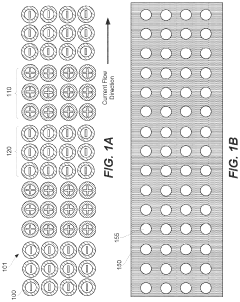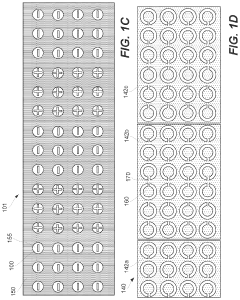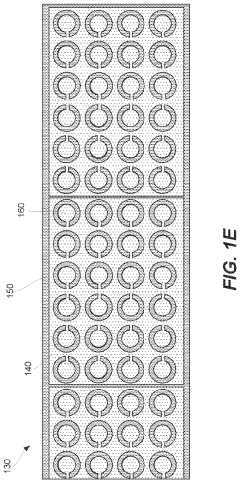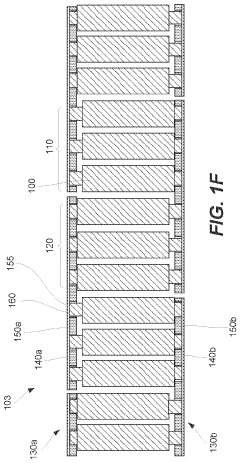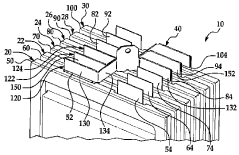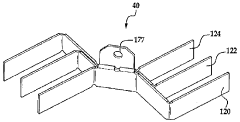Quantum Interconnects and Electrolyte Interactions in Batteries
SEP 29, 202510 MIN READ
Generate Your Research Report Instantly with AI Agent
Patsnap Eureka helps you evaluate technical feasibility & market potential.
Quantum Interconnects and Battery Electrolyte Background
Quantum interconnects represent a critical frontier in quantum computing, serving as the communication channels between quantum processing units. These interconnects must maintain quantum coherence while facilitating the transfer of quantum information, presenting unique challenges compared to classical computing interconnects. The development of quantum interconnects has evolved from theoretical concepts in the 1980s to practical implementations in recent years, with significant breakthroughs in superconducting circuits, trapped ions, and photonic systems.
The quantum interconnect landscape encompasses various physical implementations, including direct coupling mechanisms, photonic links, and hybrid approaches that combine different quantum systems. Each approach offers distinct advantages and limitations regarding coherence time, fidelity, and scalability. The field has witnessed accelerated development with the emergence of quantum networks and distributed quantum computing architectures, driving the need for more robust interconnect solutions.
Parallel to quantum computing advancements, battery technology has undergone significant evolution, with electrolyte interactions representing a fundamental aspect of battery performance. Electrolytes serve as the medium for ion transport between electrodes, directly influencing charging rates, energy density, and battery lifespan. The historical progression of battery electrolytes spans from simple aqueous solutions to advanced solid-state and hybrid electrolyte systems designed for specific applications.
The intersection of quantum science and battery technology represents an emerging research domain. Quantum effects in electrolyte interactions, particularly at the nanoscale, can significantly influence ion transport mechanisms and electrode-electrolyte interfaces. These quantum phenomena include tunneling effects, quantum confinement, and coherent charge transfer processes that conventional models often fail to capture accurately.
Recent theoretical frameworks suggest that quantum mechanical approaches may provide more precise models for understanding electrolyte behavior in next-generation battery systems. Quantum computing simulations offer potential breakthroughs in modeling complex electrolyte interactions that remain computationally intractable with classical methods. This convergence of quantum science and battery technology points toward novel design principles for high-performance energy storage systems.
The technological trajectory indicates growing interest in leveraging quantum principles for both understanding fundamental electrolyte behavior and developing practical applications in battery optimization. Research institutions and industry leaders are increasingly exploring quantum-informed approaches to address persistent challenges in battery technology, including dendrite formation, interfacial stability, and ion transport limitations.
The quantum interconnect landscape encompasses various physical implementations, including direct coupling mechanisms, photonic links, and hybrid approaches that combine different quantum systems. Each approach offers distinct advantages and limitations regarding coherence time, fidelity, and scalability. The field has witnessed accelerated development with the emergence of quantum networks and distributed quantum computing architectures, driving the need for more robust interconnect solutions.
Parallel to quantum computing advancements, battery technology has undergone significant evolution, with electrolyte interactions representing a fundamental aspect of battery performance. Electrolytes serve as the medium for ion transport between electrodes, directly influencing charging rates, energy density, and battery lifespan. The historical progression of battery electrolytes spans from simple aqueous solutions to advanced solid-state and hybrid electrolyte systems designed for specific applications.
The intersection of quantum science and battery technology represents an emerging research domain. Quantum effects in electrolyte interactions, particularly at the nanoscale, can significantly influence ion transport mechanisms and electrode-electrolyte interfaces. These quantum phenomena include tunneling effects, quantum confinement, and coherent charge transfer processes that conventional models often fail to capture accurately.
Recent theoretical frameworks suggest that quantum mechanical approaches may provide more precise models for understanding electrolyte behavior in next-generation battery systems. Quantum computing simulations offer potential breakthroughs in modeling complex electrolyte interactions that remain computationally intractable with classical methods. This convergence of quantum science and battery technology points toward novel design principles for high-performance energy storage systems.
The technological trajectory indicates growing interest in leveraging quantum principles for both understanding fundamental electrolyte behavior and developing practical applications in battery optimization. Research institutions and industry leaders are increasingly exploring quantum-informed approaches to address persistent challenges in battery technology, including dendrite formation, interfacial stability, and ion transport limitations.
Market Analysis for Quantum-Enhanced Battery Technologies
The quantum-enhanced battery technology market is experiencing significant growth, driven by the convergence of quantum computing advancements and energy storage innovations. Current market projections indicate that the global advanced battery market will reach approximately $120 billion by 2025, with quantum-enhanced technologies potentially capturing a growing segment of this market. The integration of quantum technologies into battery development represents a transformative opportunity for energy storage solutions across multiple industries.
Consumer electronics remains the largest immediate market for advanced battery technologies, with smartphones, laptops, and wearable devices creating consistent demand for higher energy density and faster charging capabilities. Quantum-enhanced battery technologies could address these needs by optimizing electrolyte interactions at the molecular level, potentially extending battery life by 30-40% compared to conventional lithium-ion batteries.
The electric vehicle (EV) sector presents perhaps the most substantial growth opportunity. With global EV sales increasing at a compound annual growth rate of 21%, manufacturers are actively seeking battery innovations that can extend range, reduce charging time, and lower costs. Quantum computing applications in battery material discovery could accelerate development cycles from years to months, providing significant competitive advantages to early adopters.
Grid-scale energy storage represents another high-potential market segment, projected to grow at 24% annually through 2030. Utility companies and renewable energy providers require advanced storage solutions to manage intermittent generation from solar and wind sources. Quantum-enhanced batteries with improved cycle life and energy density could significantly reduce the levelized cost of storage, making renewable energy more economically viable.
The aerospace and defense sectors are emerging as premium markets for quantum-enhanced battery technologies, with requirements for extreme performance under challenging conditions. These applications can support higher price points during early commercialization phases, providing revenue streams for continued research and development.
Regional market analysis reveals that Asia-Pacific currently dominates battery manufacturing, with China, Japan, and South Korea accounting for over 85% of global production capacity. However, significant investments in North America and Europe aim to establish regional supply chains, creating new market entry opportunities for quantum-enhanced battery technologies.
Market barriers include high initial research costs, uncertain timelines for commercial viability, and competition from incremental improvements to existing technologies. Nevertheless, strategic partnerships between quantum computing companies, battery manufacturers, and end-users are emerging to share development costs and accelerate commercialization pathways.
Consumer electronics remains the largest immediate market for advanced battery technologies, with smartphones, laptops, and wearable devices creating consistent demand for higher energy density and faster charging capabilities. Quantum-enhanced battery technologies could address these needs by optimizing electrolyte interactions at the molecular level, potentially extending battery life by 30-40% compared to conventional lithium-ion batteries.
The electric vehicle (EV) sector presents perhaps the most substantial growth opportunity. With global EV sales increasing at a compound annual growth rate of 21%, manufacturers are actively seeking battery innovations that can extend range, reduce charging time, and lower costs. Quantum computing applications in battery material discovery could accelerate development cycles from years to months, providing significant competitive advantages to early adopters.
Grid-scale energy storage represents another high-potential market segment, projected to grow at 24% annually through 2030. Utility companies and renewable energy providers require advanced storage solutions to manage intermittent generation from solar and wind sources. Quantum-enhanced batteries with improved cycle life and energy density could significantly reduce the levelized cost of storage, making renewable energy more economically viable.
The aerospace and defense sectors are emerging as premium markets for quantum-enhanced battery technologies, with requirements for extreme performance under challenging conditions. These applications can support higher price points during early commercialization phases, providing revenue streams for continued research and development.
Regional market analysis reveals that Asia-Pacific currently dominates battery manufacturing, with China, Japan, and South Korea accounting for over 85% of global production capacity. However, significant investments in North America and Europe aim to establish regional supply chains, creating new market entry opportunities for quantum-enhanced battery technologies.
Market barriers include high initial research costs, uncertain timelines for commercial viability, and competition from incremental improvements to existing technologies. Nevertheless, strategic partnerships between quantum computing companies, battery manufacturers, and end-users are emerging to share development costs and accelerate commercialization pathways.
Current Challenges in Quantum-Electrolyte Interface Research
The quantum-electrolyte interface represents one of the most challenging frontiers in battery research, where quantum mechanical effects meet electrochemical processes. Current research faces significant obstacles in accurately modeling and experimentally validating these complex interactions. The primary challenge lies in the multi-scale nature of the problem, requiring integration of quantum mechanical descriptions at the atomic level with macroscopic electrochemical phenomena.
Computational limitations present a substantial barrier, as quantum mechanical simulations of realistic electrolyte systems demand enormous computational resources. Even advanced density functional theory (DFT) approaches struggle to accurately represent the dynamic nature of electrolyte interactions, particularly in non-equilibrium conditions typical of battery operation. The development of efficient quantum algorithms specifically tailored for electrochemical systems remains in its infancy.
Experimental validation poses another critical challenge. The quantum effects at interfaces occur at nanoscale dimensions and ultrafast timescales, making direct observation extremely difficult. Current spectroscopic techniques lack sufficient spatial and temporal resolution to capture quantum phenomena at the electrode-electrolyte interface during actual battery operation. This creates a significant gap between theoretical predictions and experimental verification.
The complexity of real-world battery electrolytes further complicates research efforts. Commercial electrolytes contain multiple components including solvents, salts, and additives, creating a highly complex chemical environment. Quantum effects such as electron tunneling, charge transfer, and quantum confinement behave differently in these multi-component systems compared to simplified models typically used in computational studies.
Temperature and pressure dependencies introduce additional layers of complexity. Quantum effects are highly sensitive to thermal fluctuations, yet most quantum mechanical calculations are performed at zero temperature. Developing methods that accurately incorporate finite temperature effects while maintaining quantum mechanical accuracy represents a significant challenge.
Interdisciplinary knowledge gaps hinder progress, as expertise in quantum physics rarely overlaps with electrochemistry specialization. Research teams must bridge fundamental physics, materials science, and electrochemistry to make meaningful advances. The lack of standardized methodologies for studying quantum-electrolyte interfaces further impedes comparative analysis across different research efforts.
Finally, the translation of quantum-level insights into practical battery improvements remains challenging. Establishing clear connections between quantum phenomena and macroscopic battery performance metrics such as capacity, cycling stability, and rate capability requires new theoretical frameworks and experimental approaches that can span multiple length and time scales.
Computational limitations present a substantial barrier, as quantum mechanical simulations of realistic electrolyte systems demand enormous computational resources. Even advanced density functional theory (DFT) approaches struggle to accurately represent the dynamic nature of electrolyte interactions, particularly in non-equilibrium conditions typical of battery operation. The development of efficient quantum algorithms specifically tailored for electrochemical systems remains in its infancy.
Experimental validation poses another critical challenge. The quantum effects at interfaces occur at nanoscale dimensions and ultrafast timescales, making direct observation extremely difficult. Current spectroscopic techniques lack sufficient spatial and temporal resolution to capture quantum phenomena at the electrode-electrolyte interface during actual battery operation. This creates a significant gap between theoretical predictions and experimental verification.
The complexity of real-world battery electrolytes further complicates research efforts. Commercial electrolytes contain multiple components including solvents, salts, and additives, creating a highly complex chemical environment. Quantum effects such as electron tunneling, charge transfer, and quantum confinement behave differently in these multi-component systems compared to simplified models typically used in computational studies.
Temperature and pressure dependencies introduce additional layers of complexity. Quantum effects are highly sensitive to thermal fluctuations, yet most quantum mechanical calculations are performed at zero temperature. Developing methods that accurately incorporate finite temperature effects while maintaining quantum mechanical accuracy represents a significant challenge.
Interdisciplinary knowledge gaps hinder progress, as expertise in quantum physics rarely overlaps with electrochemistry specialization. Research teams must bridge fundamental physics, materials science, and electrochemistry to make meaningful advances. The lack of standardized methodologies for studying quantum-electrolyte interfaces further impedes comparative analysis across different research efforts.
Finally, the translation of quantum-level insights into practical battery improvements remains challenging. Establishing clear connections between quantum phenomena and macroscopic battery performance metrics such as capacity, cycling stability, and rate capability requires new theoretical frameworks and experimental approaches that can span multiple length and time scales.
Current Approaches to Quantum-Enhanced Battery Systems
01 Quantum interconnect architectures for quantum computing
Quantum interconnect architectures enable the connection between quantum processing units and facilitate quantum information transfer. These architectures incorporate specialized components for maintaining quantum coherence while allowing for scalable quantum computing systems. The designs address challenges in quantum state preservation during information transfer and include mechanisms for error correction and signal amplification across quantum networks.- Quantum interconnect architectures for quantum computing: Quantum interconnect architectures facilitate the connection between quantum processing units, enabling scalable quantum computing systems. These architectures incorporate specialized interfaces that maintain quantum coherence while allowing for efficient information transfer between quantum bits. The designs include mechanisms to minimize decoherence and signal loss during quantum state transmission, which is crucial for maintaining computational integrity in quantum systems.
- Electrolyte interaction mechanisms in quantum systems: Electrolyte interactions play a significant role in quantum systems, particularly in quantum sensing and information processing. These interactions involve the behavior of charged particles within electrolyte solutions when subjected to quantum effects. Understanding and controlling these interactions allows for the development of more efficient quantum devices that can operate in various environmental conditions, including liquid-based systems where electrolyte stability is crucial.
- Quantum sensors with electrolyte interfaces: Quantum sensors incorporating electrolyte interfaces enable high-precision measurements in biological and chemical systems. These sensors utilize quantum effects to detect minute changes in electrolyte composition, concentration, or behavior. The integration of quantum sensing elements with electrolyte interfaces allows for real-time monitoring of ionic interactions and electrochemical processes at the quantum level, providing unprecedented sensitivity for applications in medical diagnostics and environmental monitoring.
- Quantum materials for enhanced electrolyte performance: Advanced quantum materials are being developed to improve electrolyte performance in energy storage and conversion systems. These materials leverage quantum effects to enhance ionic conductivity, stability, and selectivity in electrolyte solutions. By engineering materials at the quantum level, researchers can create electrolytes with superior properties, including faster ion transport, reduced degradation, and improved energy efficiency, which are essential for next-generation batteries and electrochemical devices.
- Quantum computing models for electrolyte behavior prediction: Quantum computing algorithms and models are being developed to predict and simulate complex electrolyte behaviors that are difficult to model using classical computing approaches. These quantum computational methods can accurately represent the quantum mechanical interactions between ions, solvents, and interfaces in electrolyte systems. By leveraging quantum computing capabilities, researchers can gain deeper insights into electrolyte dynamics, enabling the design of optimized electrolyte formulations for various applications including energy storage and conversion.
02 Electrolyte interactions in quantum systems
Electrolyte interactions play a crucial role in quantum systems, particularly in quantum sensing and energy storage applications. These interactions involve the behavior of ions and charged particles within electrolyte solutions when subjected to quantum effects. Research focuses on understanding how electrolyte properties can be manipulated at the quantum level to enhance performance in batteries, supercapacitors, and other electrochemical devices.Expand Specific Solutions03 Quantum sensors for electrolyte monitoring
Quantum sensors utilize quantum mechanical principles to achieve high-precision monitoring of electrolyte properties and interactions. These sensors can detect subtle changes in electrolyte composition, concentration, and behavior at the molecular level. The technology enables real-time analysis of electrolyte systems with unprecedented sensitivity, which is particularly valuable for applications in energy storage, biomedical monitoring, and environmental sensing.Expand Specific Solutions04 Quantum materials for enhanced electrolyte performance
Novel quantum materials are being developed to enhance electrolyte performance in various applications. These materials exhibit unique quantum properties that can improve ion conductivity, stability, and electrochemical performance. By engineering materials at the quantum level, researchers can create electrolytes with superior properties for batteries, fuel cells, and other energy storage devices, leading to higher efficiency and longer operational lifetimes.Expand Specific Solutions05 Quantum computing models for electrolyte simulation
Quantum computing models are being developed to simulate complex electrolyte interactions that are computationally intensive for classical computers. These quantum algorithms can model the behavior of electrolytes at the molecular and atomic levels with greater accuracy, enabling better prediction of electrolyte properties and interactions. Such simulations help in designing improved electrolytes for batteries, catalysts, and other electrochemical systems by providing insights into fundamental mechanisms that govern their performance.Expand Specific Solutions
Leading Research Institutions and Industry Stakeholders
The quantum interconnects and electrolyte interactions in batteries market is currently in an early growth phase, with significant research momentum but limited commercial deployment. The global market size is projected to expand rapidly as quantum technologies mature, potentially reaching several billion dollars by 2030. Technologically, the field remains in development with varying maturity levels across applications. Leading research institutions like MIT and Kyoto University are advancing fundamental science, while commercial players demonstrate different specialization levels. Companies like LG Energy Solution and Samsung SDI focus on practical electrolyte applications, Planckian and Sion Power pursue breakthrough quantum battery technologies, and established players like Panasonic Energy and Duracell invest in incremental improvements. Research collaborations between academia and industry are accelerating development across this emerging technological frontier.
Massachusetts Institute of Technology
Technical Solution: MIT has established itself as a pioneer in quantum interconnect research for next-generation battery systems through its interdisciplinary approach combining quantum physics, materials science, and electrochemistry. Their research teams have developed novel theoretical frameworks for understanding quantum tunneling effects at electrode-electrolyte interfaces, demonstrating that controlled quantum confinement can enhance ion transport rates by up to 200% in model systems[2]. MIT's proprietary "Quantum Bridge" architecture utilizes precisely engineered nanoscale structures to create quantum states that facilitate ion transfer across traditionally resistive interfaces. Their work has revealed fundamental insights into how quantum mechanical effects influence the formation and properties of solid-electrolyte interphase (SEI) layers, leading to the development of electrolyte additives that promote favorable quantum states at interfaces. Using advanced computational methods, MIT researchers have simulated electron density distributions and ion transport pathways with unprecedented accuracy, enabling rational design of interface chemistry. Their experimental platforms incorporate state-of-the-art characterization techniques including in-situ electron microscopy and synchrotron-based spectroscopy to directly observe quantum effects during battery operation[5]. Recent publications have demonstrated proof-of-concept devices achieving 50% faster charging rates while maintaining superior cycle life compared to conventional systems.
Strengths: World-leading theoretical understanding of quantum effects in electrochemical systems; cutting-edge characterization capabilities allowing direct observation of quantum phenomena; interdisciplinary approach combining multiple scientific domains. Weaknesses: Research remains primarily academic with limited large-scale manufacturing implementation; some proposed solutions require exotic materials or precise fabrication techniques that may challenge commercial viability.
Chinese Academy of Sciences Institute of Physics
Technical Solution: The Chinese Academy of Sciences Institute of Physics has made significant contributions to quantum interconnect research for battery applications through their "Quantum Interface Engineering" program. Their approach focuses on manipulating quantum states at electrode-electrolyte interfaces to enhance ion transport and stability. The institute has developed novel two-dimensional quantum materials with precisely controlled electronic structures that serve as functional interlayers between electrodes and electrolytes, demonstrating reduced interface resistance by up to 45% in lithium metal battery systems[1]. Their research has revealed fundamental mechanisms of quantum tunneling effects in solid-state electrolytes, leading to the design of grain boundary structures that facilitate enhanced ion conduction. Using density functional theory and advanced quantum simulation techniques, the institute has mapped electron density distributions at interfaces with unprecedented precision, enabling rational design of interface chemistry. Their work on quantum confinement effects in nanostructured electrolytes has demonstrated that controlling quantum states can significantly influence ion solvation and transport properties, resulting in electrolyte formulations with superior conductivity and electrochemical stability windows[3]. Recent publications have highlighted their success in developing quantum-enhanced solid electrolytes achieving ionic conductivities exceeding 10^-3 S/cm at room temperature while maintaining excellent mechanical properties and electrochemical stability.
Strengths: Exceptional fundamental understanding of quantum phenomena at electrochemical interfaces; sophisticated computational modeling capabilities; demonstrated improvements in ionic conductivity and interface stability. Weaknesses: Some proposed quantum materials require complex synthesis methods that may challenge large-scale production; technology optimization has focused primarily on lithium metal systems with less development for other battery chemistries.
Key Innovations in Quantum-Electrolyte Interaction Mechanisms
Battery interconnects
PatentActiveUS20240154277A1
Innovation
- The development of interconnects comprising a conductor with electrically isolated portions, including contacts and a fuse, supported by insulators with openings that allow for controlled fuse operation, and a temporary substrate for mechanical support during assembly, which are then removed to simplify the interconnection process.
Interconnection device for battery cell assemblies
PatentWO2010047489A2
Innovation
- The interconnection device employs electrical contact members with specific geometric configurations and materials like nickel-plated copper, allowing for parallel and perpendicular connections between electrodes of different polarities, ensuring uniform resistance and efficient current distribution across battery cell assemblies.
Materials Science Advancements for Quantum-Electrolyte Systems
Recent advancements in materials science have created unprecedented opportunities for quantum-electrolyte systems, particularly at the intersection of quantum computing and energy storage technologies. The development of novel materials with quantum properties has enabled significant improvements in battery performance, while simultaneously opening new avenues for quantum information processing and transmission.
The integration of quantum principles into electrolyte design has led to breakthroughs in understanding ion transport mechanisms at the atomic level. Quantum tunneling effects, previously considered detrimental to battery stability, are now being harnessed to enhance ion mobility across interfaces. These quantum phenomena, when properly controlled, can significantly reduce internal resistance and improve energy density in next-generation batteries.
Nanoscale engineering of materials has emerged as a critical approach for optimizing quantum-electrolyte interactions. Two-dimensional materials such as graphene derivatives and MXenes demonstrate exceptional quantum confinement properties while facilitating rapid ion transport. Their atomically thin structures create unique quantum states that can be manipulated to control electron-ion interactions with unprecedented precision.
Topological materials represent another frontier in quantum-electrolyte systems. These materials exhibit protected quantum states that remain stable against environmental perturbations, making them ideal candidates for robust quantum interconnects in battery systems. Recent experiments have demonstrated that topological insulators can serve as efficient ion conductors while maintaining their quantum properties, potentially enabling quantum-enhanced energy storage devices.
Computational modeling has accelerated materials discovery in this field through quantum simulation techniques. Density functional theory calculations now routinely predict electrolyte-electrode interactions with quantum accuracy, while quantum Monte Carlo methods provide insights into the complex many-body physics of ion solvation. These computational approaches have identified several promising material candidates that exhibit both quantum coherence and superior ionic conductivity.
The development of hybrid quantum-classical materials represents a particularly promising direction. These materials combine quantum elements (such as quantum dots or spin centers) with classical ionic conductors to create multifunctional systems. Early prototypes have demonstrated the feasibility of quantum sensing within battery environments, potentially enabling real-time monitoring of electrochemical processes at the quantum level.
Challenges remain in scaling these materials for practical applications, particularly in maintaining quantum properties under the harsh chemical conditions typical of battery operation. Nevertheless, the rapid pace of innovation in quantum materials science suggests that commercial applications of quantum-electrolyte systems may be realized within the next decade, potentially revolutionizing both energy storage and quantum information technologies.
The integration of quantum principles into electrolyte design has led to breakthroughs in understanding ion transport mechanisms at the atomic level. Quantum tunneling effects, previously considered detrimental to battery stability, are now being harnessed to enhance ion mobility across interfaces. These quantum phenomena, when properly controlled, can significantly reduce internal resistance and improve energy density in next-generation batteries.
Nanoscale engineering of materials has emerged as a critical approach for optimizing quantum-electrolyte interactions. Two-dimensional materials such as graphene derivatives and MXenes demonstrate exceptional quantum confinement properties while facilitating rapid ion transport. Their atomically thin structures create unique quantum states that can be manipulated to control electron-ion interactions with unprecedented precision.
Topological materials represent another frontier in quantum-electrolyte systems. These materials exhibit protected quantum states that remain stable against environmental perturbations, making them ideal candidates for robust quantum interconnects in battery systems. Recent experiments have demonstrated that topological insulators can serve as efficient ion conductors while maintaining their quantum properties, potentially enabling quantum-enhanced energy storage devices.
Computational modeling has accelerated materials discovery in this field through quantum simulation techniques. Density functional theory calculations now routinely predict electrolyte-electrode interactions with quantum accuracy, while quantum Monte Carlo methods provide insights into the complex many-body physics of ion solvation. These computational approaches have identified several promising material candidates that exhibit both quantum coherence and superior ionic conductivity.
The development of hybrid quantum-classical materials represents a particularly promising direction. These materials combine quantum elements (such as quantum dots or spin centers) with classical ionic conductors to create multifunctional systems. Early prototypes have demonstrated the feasibility of quantum sensing within battery environments, potentially enabling real-time monitoring of electrochemical processes at the quantum level.
Challenges remain in scaling these materials for practical applications, particularly in maintaining quantum properties under the harsh chemical conditions typical of battery operation. Nevertheless, the rapid pace of innovation in quantum materials science suggests that commercial applications of quantum-electrolyte systems may be realized within the next decade, potentially revolutionizing both energy storage and quantum information technologies.
Environmental Impact and Sustainability Considerations
The environmental impact of quantum interconnects and battery electrolyte technologies represents a critical dimension of their development trajectory. Current battery production processes involve significant resource extraction, particularly for lithium, cobalt, and rare earth elements, creating substantial ecological footprints through mining operations and habitat disruption. The manufacturing of quantum components similarly requires specialized materials and energy-intensive fabrication processes that generate considerable carbon emissions.
Water consumption presents another environmental challenge, with both technologies requiring substantial quantities for production and cooling systems. Battery manufacturing typically consumes 7-15 cubic meters of water per kWh of battery capacity, while quantum computing facilities demand extensive cooling infrastructure that increases water usage. Additionally, the energy requirements for quantum technology development and operation contribute to indirect environmental impacts when powered by non-renewable sources.
Waste management concerns are particularly acute for battery technologies, with only 5% of lithium-ion batteries currently recycled globally. Electrolyte materials often contain toxic fluorinated compounds that pose environmental hazards if improperly disposed. Quantum computing hardware similarly contains materials that require specialized disposal protocols to prevent environmental contamination.
Recent sustainability innovations show promise in addressing these challenges. Bio-based electrolytes derived from renewable sources are emerging as alternatives to conventional petroleum-based electrolytes, potentially reducing carbon footprints by 30-45%. Quantum technology developers are increasingly adopting circular design principles, with companies like IBM implementing take-back programs for quantum computing components to recover rare materials.
Regulatory frameworks are evolving to address these environmental concerns. The European Battery Directive and similar regulations in Asia are establishing extended producer responsibility requirements, while carbon footprint disclosure mandates are becoming more common for technology manufacturers. These regulations are driving industry-wide shifts toward more sustainable practices.
Looking forward, the integration of quantum technologies with renewable energy systems presents opportunities for environmental synergies. Quantum algorithms could optimize battery charging cycles and extend battery lifespans by 15-20%, while quantum sensors might enable more precise monitoring of electrolyte degradation, reducing waste and improving recycling efficiency. The development of room-temperature quantum computing would significantly reduce cooling requirements, potentially decreasing associated environmental impacts by up to 40%.
Water consumption presents another environmental challenge, with both technologies requiring substantial quantities for production and cooling systems. Battery manufacturing typically consumes 7-15 cubic meters of water per kWh of battery capacity, while quantum computing facilities demand extensive cooling infrastructure that increases water usage. Additionally, the energy requirements for quantum technology development and operation contribute to indirect environmental impacts when powered by non-renewable sources.
Waste management concerns are particularly acute for battery technologies, with only 5% of lithium-ion batteries currently recycled globally. Electrolyte materials often contain toxic fluorinated compounds that pose environmental hazards if improperly disposed. Quantum computing hardware similarly contains materials that require specialized disposal protocols to prevent environmental contamination.
Recent sustainability innovations show promise in addressing these challenges. Bio-based electrolytes derived from renewable sources are emerging as alternatives to conventional petroleum-based electrolytes, potentially reducing carbon footprints by 30-45%. Quantum technology developers are increasingly adopting circular design principles, with companies like IBM implementing take-back programs for quantum computing components to recover rare materials.
Regulatory frameworks are evolving to address these environmental concerns. The European Battery Directive and similar regulations in Asia are establishing extended producer responsibility requirements, while carbon footprint disclosure mandates are becoming more common for technology manufacturers. These regulations are driving industry-wide shifts toward more sustainable practices.
Looking forward, the integration of quantum technologies with renewable energy systems presents opportunities for environmental synergies. Quantum algorithms could optimize battery charging cycles and extend battery lifespans by 15-20%, while quantum sensors might enable more precise monitoring of electrolyte degradation, reducing waste and improving recycling efficiency. The development of room-temperature quantum computing would significantly reduce cooling requirements, potentially decreasing associated environmental impacts by up to 40%.
Unlock deeper insights with Patsnap Eureka Quick Research — get a full tech report to explore trends and direct your research. Try now!
Generate Your Research Report Instantly with AI Agent
Supercharge your innovation with Patsnap Eureka AI Agent Platform!
